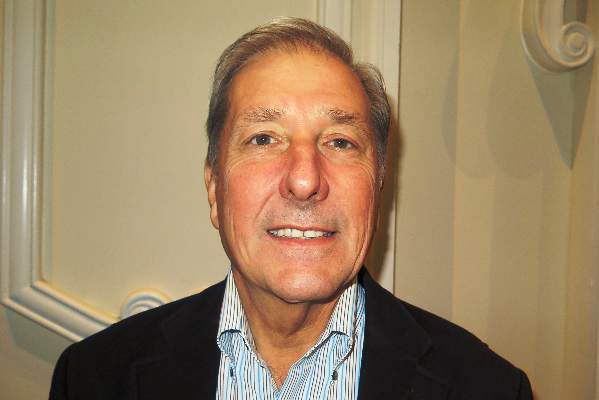User login
LAS VEGAS – If a child presents with ash-leaf spots or small hypopigmented “confetti” lesions, think tuberous sclerosis, a neurocutaneous disorder that affects an estimated 1:6,000-10,000 infants and children.
“The neurologic impact of tuberous sclerosis is much higher than it is for neurofibromatosis,” Dr. Thomas K. Koch said at a pediatric update sponsored by the American Academy of Pediatrics California District 9. “These are children that may present to you early on with infantile spasms and/or may have severe psychomotor deficits and difficult seizures. We need to understand the needs of these children across the spectrum as well as what other organ systems can be involved with these kids.”
Dr. Koch, professor of pediatric neurology at the Medical University of South Carolina, Charleston, described tuberous sclerosis (TSC) as an autosomal dominant disorder with variable penetrance. It can affect multiple organs, including the brain, skin, eyes, heart, kidney, and lungs. It involves two different genes on two different chromosomes: the TSC 1 gene on 9q34 called hamartin and the TSC 2 gene on 16p13 called tuberin. “Hamartin and tuberin act together in the Golgi apparatus for regulation of cell division,” he explained. “This leads to the proclivity toward development of abnormal tissue [such as] hamartomas.”
The long-established classical clinical triad to make a diagnosis of TSC was the presence of a seizure disorder, mental retardation, and cutaneous findings, especially adenoma sebaceum. However, that clinical triad occurs in fewer than 50% of patients, Dr. Koch said. According to a 2000 National Institutes of Health consensus conference, definite TSC can be made by the presence of two major features or one major plus two minor features; probable TSC is defined as having one major feature plus one minor feature, while possible TSC is defined as having one major feature or two or more minor features (Arch. Neurol. 2000;57:662-5).
Major features of TSC include cutaneous lesions such as adenoma sebaceum, more than three hypomelanotic macules, shagreen patch, and periungual fibromas; cortical tubers, subependymal nodules, retinal hamartomas, heart rhabdomyomas, renal angiomyolipomas, and lung lymphangiomyomatosis. Minor features include bone cysts, confetti skin lesions, CNS white matter migration abnormalities, dental enamel pits, gingival fibromas, rectal polyps, multiple renal cysts, non-renal hamartomas, and a retinal achromic patch.
One common cutaneous manifestation of TSC is adenoma sebaceum, which usually develops at an age of 4-6 years and is located over the nose, cheeks, chin, and can include the forehead. Another cutaneous manifestation is a shagreen patch: a roughened, raised lesion with an orange-peel consistency almost always located over the lumbosacral region. Approximately 90% of cases have ash leaf spots whose visualization is enhanced by a Woods lamp. “This is one of the first cutaneous manifestations you will see,” Dr. Koch said. “Many of the cutaneous manifestations develop as a function of time. Subungual and periungual fibromas usually arise during adolescence.”
From a central nervous system standpoint, at least 80% of TSC cases have some form of a cognitive or mental disability. Epilepsy is seen in 80%-90% of cases. “If a child presents with infantile spasms, the first thing you have to think about is tuberous sclerosis, because if TSC presents in infancy, it will do so as infantile spasms,” he said.
Dr. Koch reported having no relevant financial disclosures.
On Twitter @dougbrunk
LAS VEGAS – If a child presents with ash-leaf spots or small hypopigmented “confetti” lesions, think tuberous sclerosis, a neurocutaneous disorder that affects an estimated 1:6,000-10,000 infants and children.
“The neurologic impact of tuberous sclerosis is much higher than it is for neurofibromatosis,” Dr. Thomas K. Koch said at a pediatric update sponsored by the American Academy of Pediatrics California District 9. “These are children that may present to you early on with infantile spasms and/or may have severe psychomotor deficits and difficult seizures. We need to understand the needs of these children across the spectrum as well as what other organ systems can be involved with these kids.”
Dr. Koch, professor of pediatric neurology at the Medical University of South Carolina, Charleston, described tuberous sclerosis (TSC) as an autosomal dominant disorder with variable penetrance. It can affect multiple organs, including the brain, skin, eyes, heart, kidney, and lungs. It involves two different genes on two different chromosomes: the TSC 1 gene on 9q34 called hamartin and the TSC 2 gene on 16p13 called tuberin. “Hamartin and tuberin act together in the Golgi apparatus for regulation of cell division,” he explained. “This leads to the proclivity toward development of abnormal tissue [such as] hamartomas.”
The long-established classical clinical triad to make a diagnosis of TSC was the presence of a seizure disorder, mental retardation, and cutaneous findings, especially adenoma sebaceum. However, that clinical triad occurs in fewer than 50% of patients, Dr. Koch said. According to a 2000 National Institutes of Health consensus conference, definite TSC can be made by the presence of two major features or one major plus two minor features; probable TSC is defined as having one major feature plus one minor feature, while possible TSC is defined as having one major feature or two or more minor features (Arch. Neurol. 2000;57:662-5).
Major features of TSC include cutaneous lesions such as adenoma sebaceum, more than three hypomelanotic macules, shagreen patch, and periungual fibromas; cortical tubers, subependymal nodules, retinal hamartomas, heart rhabdomyomas, renal angiomyolipomas, and lung lymphangiomyomatosis. Minor features include bone cysts, confetti skin lesions, CNS white matter migration abnormalities, dental enamel pits, gingival fibromas, rectal polyps, multiple renal cysts, non-renal hamartomas, and a retinal achromic patch.
One common cutaneous manifestation of TSC is adenoma sebaceum, which usually develops at an age of 4-6 years and is located over the nose, cheeks, chin, and can include the forehead. Another cutaneous manifestation is a shagreen patch: a roughened, raised lesion with an orange-peel consistency almost always located over the lumbosacral region. Approximately 90% of cases have ash leaf spots whose visualization is enhanced by a Woods lamp. “This is one of the first cutaneous manifestations you will see,” Dr. Koch said. “Many of the cutaneous manifestations develop as a function of time. Subungual and periungual fibromas usually arise during adolescence.”
From a central nervous system standpoint, at least 80% of TSC cases have some form of a cognitive or mental disability. Epilepsy is seen in 80%-90% of cases. “If a child presents with infantile spasms, the first thing you have to think about is tuberous sclerosis, because if TSC presents in infancy, it will do so as infantile spasms,” he said.
Dr. Koch reported having no relevant financial disclosures.
On Twitter @dougbrunk
LAS VEGAS – If a child presents with ash-leaf spots or small hypopigmented “confetti” lesions, think tuberous sclerosis, a neurocutaneous disorder that affects an estimated 1:6,000-10,000 infants and children.
“The neurologic impact of tuberous sclerosis is much higher than it is for neurofibromatosis,” Dr. Thomas K. Koch said at a pediatric update sponsored by the American Academy of Pediatrics California District 9. “These are children that may present to you early on with infantile spasms and/or may have severe psychomotor deficits and difficult seizures. We need to understand the needs of these children across the spectrum as well as what other organ systems can be involved with these kids.”
Dr. Koch, professor of pediatric neurology at the Medical University of South Carolina, Charleston, described tuberous sclerosis (TSC) as an autosomal dominant disorder with variable penetrance. It can affect multiple organs, including the brain, skin, eyes, heart, kidney, and lungs. It involves two different genes on two different chromosomes: the TSC 1 gene on 9q34 called hamartin and the TSC 2 gene on 16p13 called tuberin. “Hamartin and tuberin act together in the Golgi apparatus for regulation of cell division,” he explained. “This leads to the proclivity toward development of abnormal tissue [such as] hamartomas.”
The long-established classical clinical triad to make a diagnosis of TSC was the presence of a seizure disorder, mental retardation, and cutaneous findings, especially adenoma sebaceum. However, that clinical triad occurs in fewer than 50% of patients, Dr. Koch said. According to a 2000 National Institutes of Health consensus conference, definite TSC can be made by the presence of two major features or one major plus two minor features; probable TSC is defined as having one major feature plus one minor feature, while possible TSC is defined as having one major feature or two or more minor features (Arch. Neurol. 2000;57:662-5).
Major features of TSC include cutaneous lesions such as adenoma sebaceum, more than three hypomelanotic macules, shagreen patch, and periungual fibromas; cortical tubers, subependymal nodules, retinal hamartomas, heart rhabdomyomas, renal angiomyolipomas, and lung lymphangiomyomatosis. Minor features include bone cysts, confetti skin lesions, CNS white matter migration abnormalities, dental enamel pits, gingival fibromas, rectal polyps, multiple renal cysts, non-renal hamartomas, and a retinal achromic patch.
One common cutaneous manifestation of TSC is adenoma sebaceum, which usually develops at an age of 4-6 years and is located over the nose, cheeks, chin, and can include the forehead. Another cutaneous manifestation is a shagreen patch: a roughened, raised lesion with an orange-peel consistency almost always located over the lumbosacral region. Approximately 90% of cases have ash leaf spots whose visualization is enhanced by a Woods lamp. “This is one of the first cutaneous manifestations you will see,” Dr. Koch said. “Many of the cutaneous manifestations develop as a function of time. Subungual and periungual fibromas usually arise during adolescence.”
From a central nervous system standpoint, at least 80% of TSC cases have some form of a cognitive or mental disability. Epilepsy is seen in 80%-90% of cases. “If a child presents with infantile spasms, the first thing you have to think about is tuberous sclerosis, because if TSC presents in infancy, it will do so as infantile spasms,” he said.
Dr. Koch reported having no relevant financial disclosures.
On Twitter @dougbrunk
EXPERT ANALYSIS FROM PEDIATRIC UPDATE

